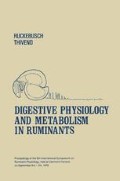Abstract
Research on ruminant digestion is essentially a study of interactions among host, micro-organisms, substrates and end-products of digestion. That these interactions are extremely complex is obvious. It is also obvious that progress in understanding the basis of these interactions has been, and will be, slow using traditional experimental methods. Furthermore, most of our knowledge of these interactions is qualitative and must be extended quantitatively in context with the total system we seek to understand. This is not to imply that we do not have good quantitative data regarding specific aspects of ruminant digestive function; we do. The problem is integration of available concepts and data regarding ruminant digestive function and quantitative and dynamic evaluation of these in the context of behaviour of the total system. Some years ago, we, among others, undertook the effort of learning mathematical approaches appropriate to achievement of this objective because we thought the approach held promise. Based on progress and results achieved (by ourselves and others), we are convinced that simulation modelling of digestive function is an extremely powerful technique and possibly the only approach available which enables rigorous, quantitative evaluation of our understanding of ruminant digestive function and effective or maximal use of this knowledge in the solution of animal and food production problems.
Access this chapter
Tax calculation will be finalised at checkout
Purchases are for personal use only
Preview
Unable to display preview. Download preview PDF.
References
Al-Rabbal, M. F., Baldwin, R. L. and Weir, W. C. (1971). Microbial growth dependence on ammonia nitrogen in the bovine rumen. A quantitative study. J. Dairy Sci., 54, 1162–1172
Baldwin, R. L., Koong, L. J. and Ulyatt, M. J. (1977). A dynamic model of ruminant digestion for evaluation of factors affecting nutritive value. Agric. Syst., 2, 255–288
Baldwin, R. L., Koong, L. J. and Ulyatt, M. J. (1977). The formation and utilization of fermentation end-products. Mathematical models, pp. 347–391. In R. T. J. Clarke and T. Bauchop (eds.): Microbial Ecology of the Normal Gut. (London: Academic Press)
Baldwin, R. L. and Denham, S. C. (1979). Quantitative and dynamic aspects of nitrogen metabolism in the rumen. A modelling analysis. J. Dairy Sci. (In press)
Bard, Y. (1974). Non-Linear Parameter Estimation. (New York: Academic Press)
Blaxter, K. L., Graham, N. McC. and Wainman, F. W. (1956). Some observations on the digestibility of food by sheep, and on related problems. Br. J. Nutr 10, 69–91
De Witt, C. T. (1969). Dynamic concepts in biology. In I. Setlik (ed.): Prediction and Measurement of Photosynthetic Productivity. Proc. IBP/PP Technical Meeting, Trebon Symposium, pp. 17–23
Fishman, G. S. and Kiviat, P. J. (1967). The analysis of simulation-generated time series. Management Sci., 13, 525–557
Hogan, J. P. (1975). Quantitative aspects of nitrogen utilization in ruminants. J. Dairy Sci.,58, 1164–1177
Hume, I. D. (1970). Synthesis of microbial protein in the rumen. III. The effect of dietary protein. Aust. J. Agric. Res.,21, 305
Koong, L. J., Baldwin, R. L., Ulyatt, M. J. and Charlesworth, T. J. (1975). Iterative computation of metabolic flux and stoichiometric parameters for alternate pathways in rumen fermentation. Comput. Program Biomed., 4, 209–213
Koong, L. J., Baldwin, R. L. and Ulyatt, M. J. (1978). The application of systems analysis of mathematical modelling techniques to animal science research. Symposium on use of the computer in animal science teaching, research and extension. Am. Soc. Anim. Sci., 9–19
Lucas, H. L. (1976). Formulation and role of input-output models in animal production. In Proceedings of the First International Symposium on Feed Composition, Animal Nutrient Requirement, and Computerization of Diets. (Utah: Logan)
Maeng, W. J. and Baldwin, R. L. (1976). Factors influencing rumen microbial growth rates and yields. Effects of urea and amino acids over time. J. Dairy Sci., 59, 643–647
Matis, J. H. and Hartley, H. O. (1971). Stochastic compartmental analysis. Model and least squares estimation from time series data. Biometrics, 27, 77–102
Mehrez, A. Z., Orskov, E. R. and McDonald, I. (1977). Rates of rumen fermentation in relation to ammonia concentration. Brit. J. Nutr., 38,447
Reichl, J. R. and Baldwin, R. L. (1975). Rumen modelling: Rumen input-output balance models. J. Dairy Sci., 58, 879–890
Reichl, J. R. and Baldwin, R. L. (1976). A rumen linear programming model for evaluation of concepts of rumen microbial function. J. Dairy Sci., 59, 439–454
Rice, R. W., Morris, J. G., Maeda, B. T. and Baldwin, R. L. (1974). Simulation of animal functions in models of production systems. Ruminants on the range. Fed. Proc., 33, 188–195
Riggs, D. S. (1963). The Mathematical Approach to Physiological Problems. (Massachusetts: MIT Press)
Russell, J. B. and Baldwin, R. L. (1978). Substrate preferences in rumen bacteria. Evidence of catabolite regulatory mechanisms. Appl. Environ. Microbiol., 36, 319–329
Russell, J. B. (1978). Factors affecting competitions among rumen bacteria. Ph.D Thesis, University of California, Davis
Satter, L. D. and Roffler, R. E. (1975). Nitrogen requirements and utilization in dairy cattle. J. Dairy Sci., 58, 1219–1237
Ulyatt, M. J., Baldwin, R. L. and Koong, L. J. (1976). The basis of nutritive value-a modelling approach. Proc. N. Z. Soc. Anim. Proc., 36, 140–149
Van Horn, R. L. (1971). Validation of simulation results. Management Sci., 17, 247–258
Editor information
Editors and Affiliations
Rights and permissions
Copyright information
© 1980 MTP Press Limited
About this chapter
Cite this chapter
Baldwin, R.L., Koong, L.J. (1980). Mathematical modelling in analyses of ruminant digestive function: philosophy, methodology and application. In: Ruckebusch, Y., Thivend, P. (eds) Digestive Physiology and Metabolism in Ruminants. Springer, Dordrecht. https://doi.org/10.1007/978-94-011-8067-2_12
Download citation
DOI: https://doi.org/10.1007/978-94-011-8067-2_12
Publisher Name: Springer, Dordrecht
Print ISBN: 978-94-011-8069-6
Online ISBN: 978-94-011-8067-2
eBook Packages: Springer Book Archive

